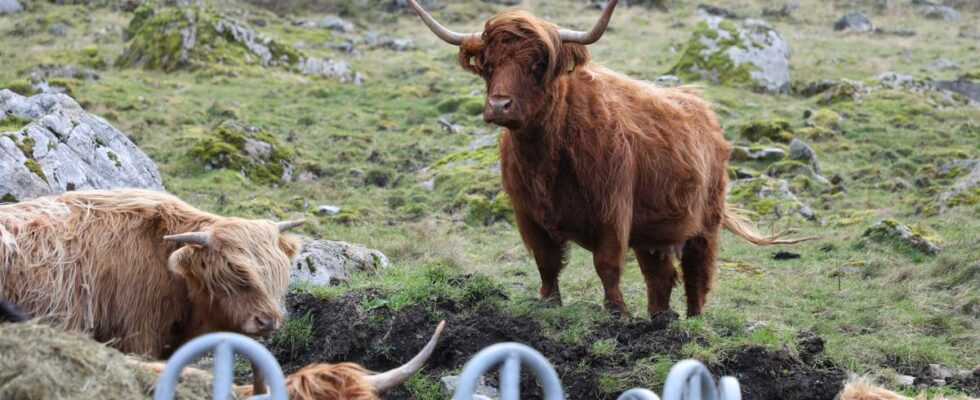From 1 November, Nortura will stop accepting Scottish Highland cattle for slaughter. The reason is consideration for the employees and their safety. – We have had episodes where people have lost the sight of one eye. They have been impaled, had the horn in their stomachs and been a throwing ball. Then it’s serious, says Ove Drange, factory manager for Nortura Egersund. Nortura has had near misses and accidents with Scottish Highland cattle at several of the plants. In addition, there have been several cases where animals have caused serious damage to each other during transport. Therefore, they have taken the decision to say no to the reception of animals with long horns (external link). Ove Drange is factory manager for Nortura Egersund. He believes it is entirely appropriate to say no to the slaughter of Scottish Highland cattle. Photo: Odd Rune Kyllingstad / news Factory manager Drange has no doubt that it is the right decision. – The animals are potential killing machines, he says. Drange has previously stated to Dalane Tidende that Nortura is experiencing broad support for the slaughter stop which will soon become a fact. – I am happy, and I think I have 5,000 employees with me who are also happy that we value safety, he says to news. Scottish highland cattle Photo: Odd Rune Kyllingstad / news Hardy, thrifty and primitive livestock breed of cattle. Belongs to north-west Scotland. The Scottish breed name, Highland Cattle, is also often used in Norway. Has powerful, outgoing, large horns and long hair. The color varies between yellow and dark brown. Has been registered in Norway since 1993, with approximately 1,500 mother animals and 530 registered animals in the beef inspection (2019). Source: Store norske lexikon Nortura believes it is breaching its duty of acceptance In Bjerkreim, south of Rogaland, farmer Anne Pearl Gravdal has run Scottish Highland cattle for 15 years. – They are absolutely fantastic. They are so cute. Gravdal emphasizes that she understands that Nortura values the safety of its employees. – These are animals that are not used to being in regular barns. When they go into the slaughterhouses, they can become scared, stressed and dangerous, she says. Anne Pearl Gravdal is one of around 200 farmers who are considering giving up Scottish Highland cattle. She will not dehorn the calves. – Then all the charm with them is gone, she says. Photo: Odd Rune Kyllingstad / news Frank Halvard Valø, leader of the association Norsk Highland Cattle, on the other hand reacts strongly to the decision from Nortura. – I changed my operation to Scottish Highland cattle a year and a half ago. Now I have 29 animals with horns that are worthless. Valø, who himself lives in Troms, says farmers in the three northernmost counties do not have access to private slaughterhouses. – Nortura has in practice given us an operating ban. I believe there is also a breach of the duty to receive. We have to close down our farms at a loss, and I would compare our situation to that of the fur industry. – This is awful, and for my own part I have no idea what to do, he continues. Valø does not recognize that Scottish highland cattle are so dangerous. – I just show them the power-restricted ones, and they follow me. They’re like dogs, really. Frank Halvard Valø. Photo: Privat Nortura: – Constitutes an unacceptable risk Press manager John Trygve Tollefsen at Nortura believes it would be wrong to say that the company has banned the operation of Scottish Highland cattle. – The reason why we will no longer accept animals with long horns is that these pose an unacceptable risk of injury, he writes in an e-mail to news. John Trygve Tollefsen, press manager at Nortura. Photo: Nortura – Valø i Norsk Highland Cattle believes this is a breach of the acceptance obligation? – We have authority to refuse reception of highland cattle. Nortura has assessed that the reception obligation must be waived in connection with situations where this comes at the expense of acceptable animal welfare or entails serious risk for the employees, Tollefsen replies. He points out that Nortura announced the slaughter stop back in March 2023. Dehorning of cattle – must be done within six weeks Dehorning is removing the facilities for cattle’s horns. Among other things, this is done to reduce the risk of injury when the animal is an adult. The horn system in calves is removed by burning. The operation must be carried out by a veterinarian using anaesthetic, and according to the regulations it must be carried out before the animals are six weeks old. Source: Great Norwegian Lexicon Fatland still accepts Scottish Highland cattle In Fatland, which unlike Nortura is a private company, they still accept Scottish Highland cattle for slaughter. But only at the plant in Ølen, not in Oslo and on Jæren. – In Ølen, we have a system that allows us to accept animals with long horns. The safety of both our employees and others who are in contact with the animals is the most important thing for us, says general manager Ove Malvin Knutsen at Fatland Oslo. In Fatland, they have not had any negative incidents related to Scottish Highland cattle. Scottish highland cattle are a hardy cuirass that lives outdoors. These cows are not used to barns. Photo: Odd Rune Kyllingstad / news Published 22.10.2024, at 05.17
ttn-69
Stops slaughtering Scottish Highland cattle – calls the animals “potential killing machines” – news Rogaland – Local news, TV and radio

